Amphibians page 2---Bullfrogs!
This page was born
04/29/2016. Rickubis designed it. (such as it is.) Last
update: 01/26/2025
Images and contents on this page copyright ©2002-2025 Richard M. Dashnau
Go back to my home page, Welcome to
rickubis.com
Go
back
to the RICKUBISCAM page.
06/16/2024
Sometimes, the American Bullfrog (Lithobates
catesbeiana) are chorusing where I can see them. Even so, it
can be hard to focus on the one that
decides to call. I got lucky on this day. The frog's ear is the
circle behind the eye. In males, the circle is much larger than
the eye. That circle is the ear drum, and the raised area in
the middle
is a thickened pad. After the first two images, the
remaining photos are frames from video filmed at 480fps. In
those images, we can see a lot is going on in the water around the
frog.
Wonderful acoustic signatures become clear. The edited video shows the Bullfrog calling at
normal frame rate, then two slower frame rates.
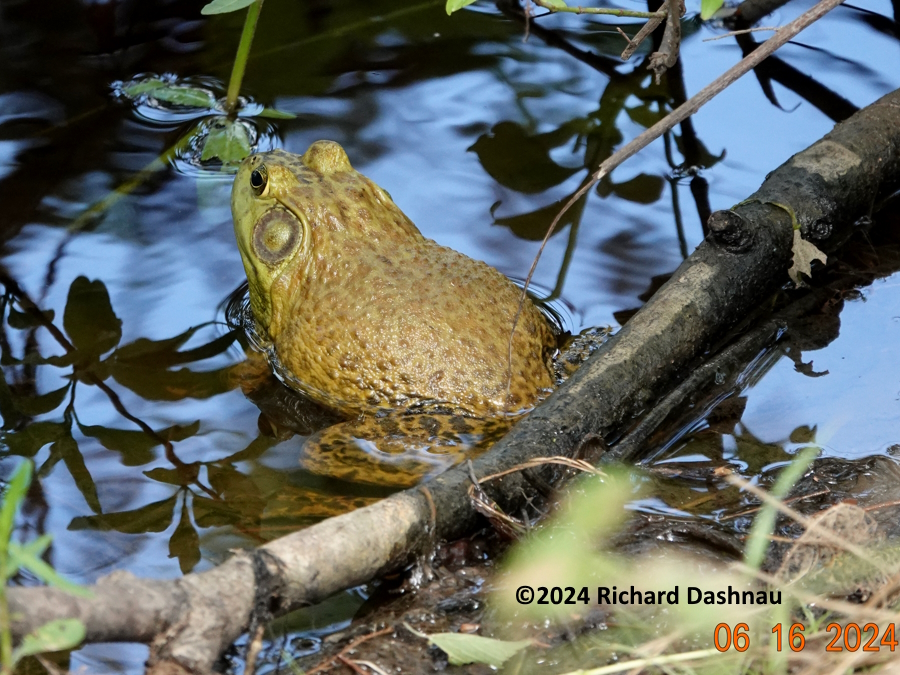
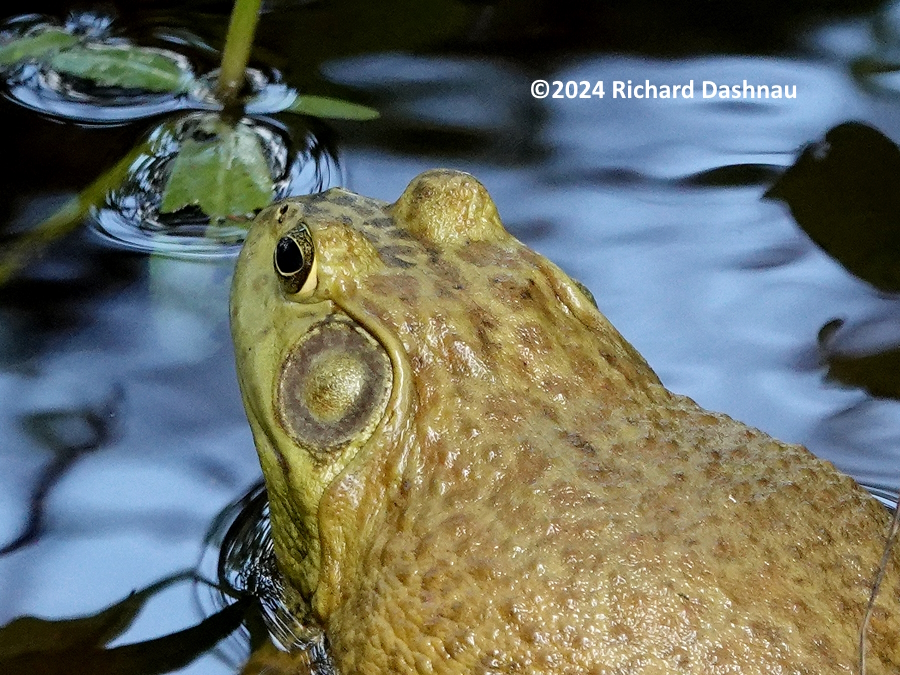
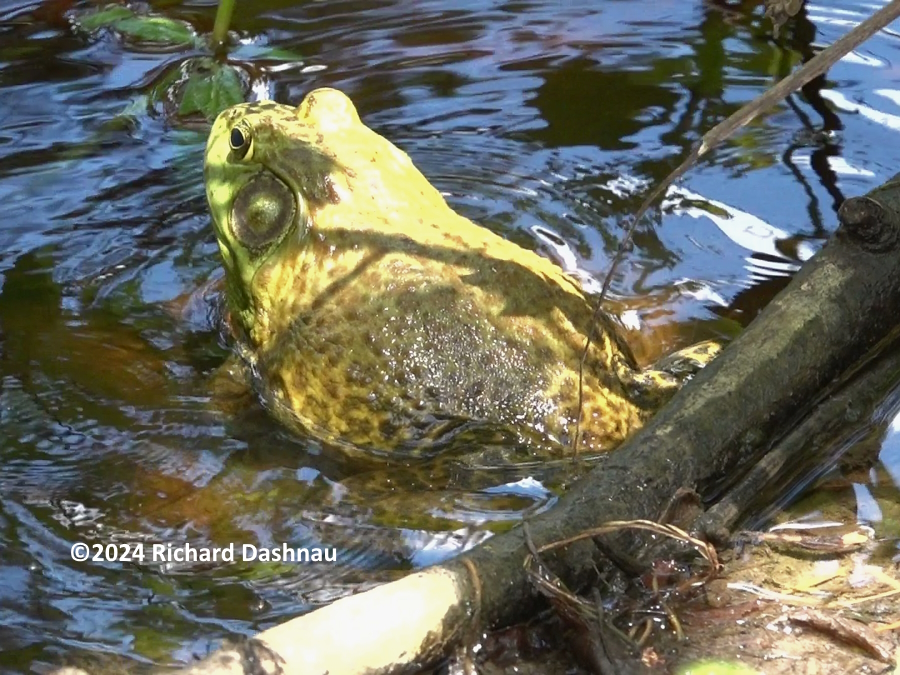
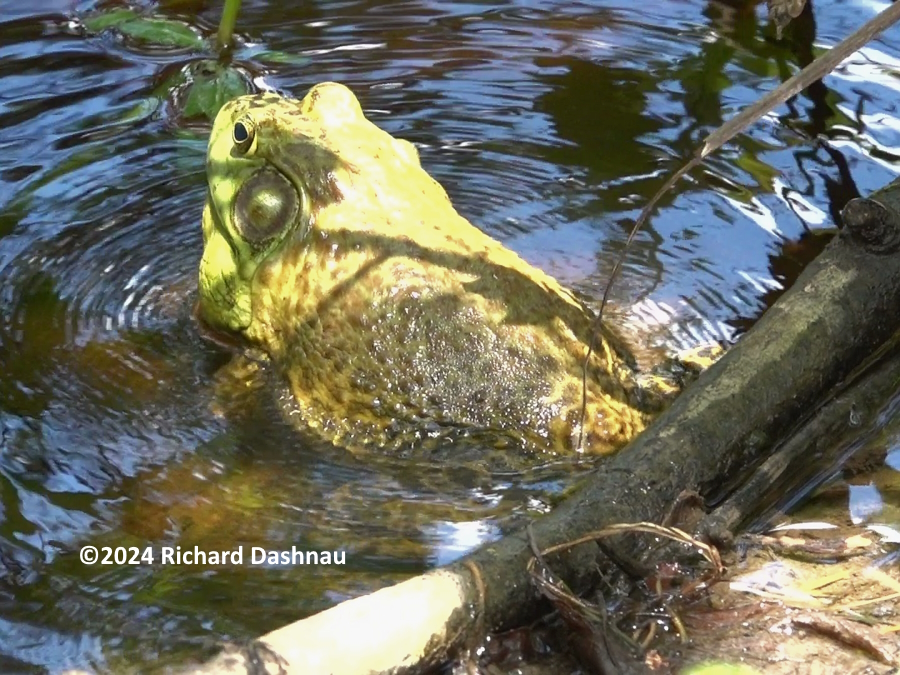
Water
droplets are dancing off the sides of the frog, and circular wave
patterns seem to emanate from throat and sides. The slowed video
shows that there is also something happening
with the ears. Recording cyclic activity with video can be tricky.
If the video frame rate is the same as the movement cycle, then no
movement is visible since each frame shows the
object in the same place. So I cropped the video and slowed
playback to 24x. Then I could see pulsation of the ear drums
(tympanic membranes (TM)); and the separate circular wave
patterns crossing each other.
Although the male Bullfrogs have an eardrum at least 50% larger
than females', they don't hear better. "Function of the sexually
dimorphic ear of the American bullfrog"
(Werner et. al. 2009) suggests the big pad in the middle acts as a
damper to offset the larger membrane size. So why are
the males' ears bigger? "Tympanic sound radiation in the
bullfrog" (A.P. Purgue 1997) suggests that the ears are resonators
to amplify sound. So the larger ears don't help males hear
better--they help then sound better...or louder.
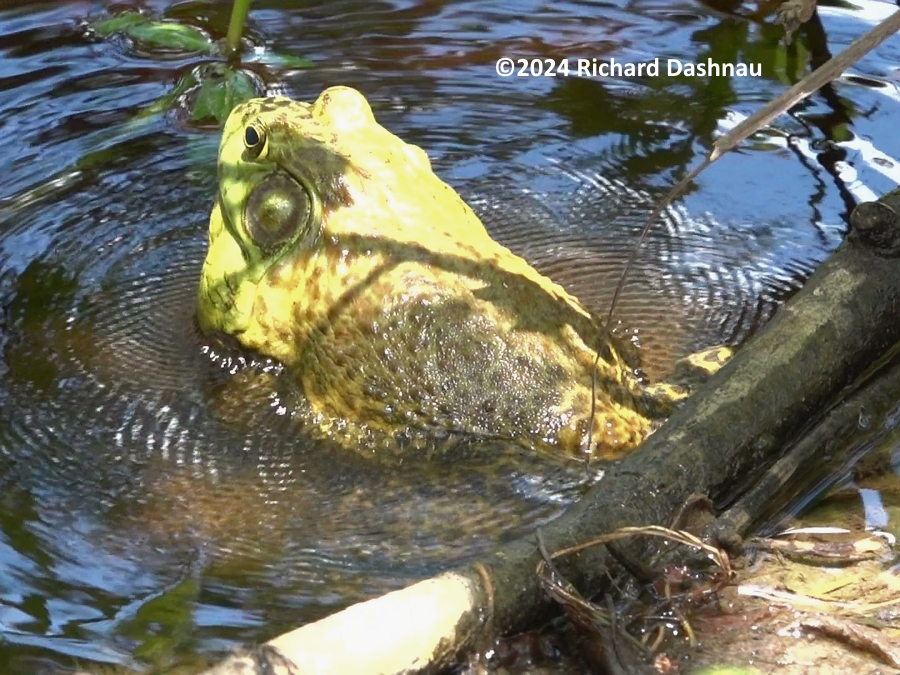
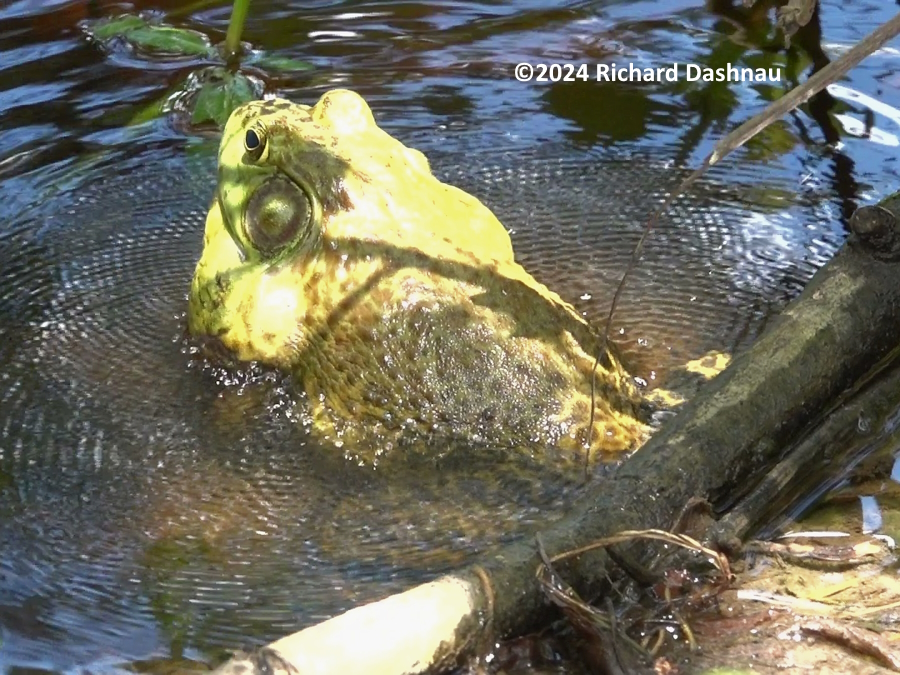
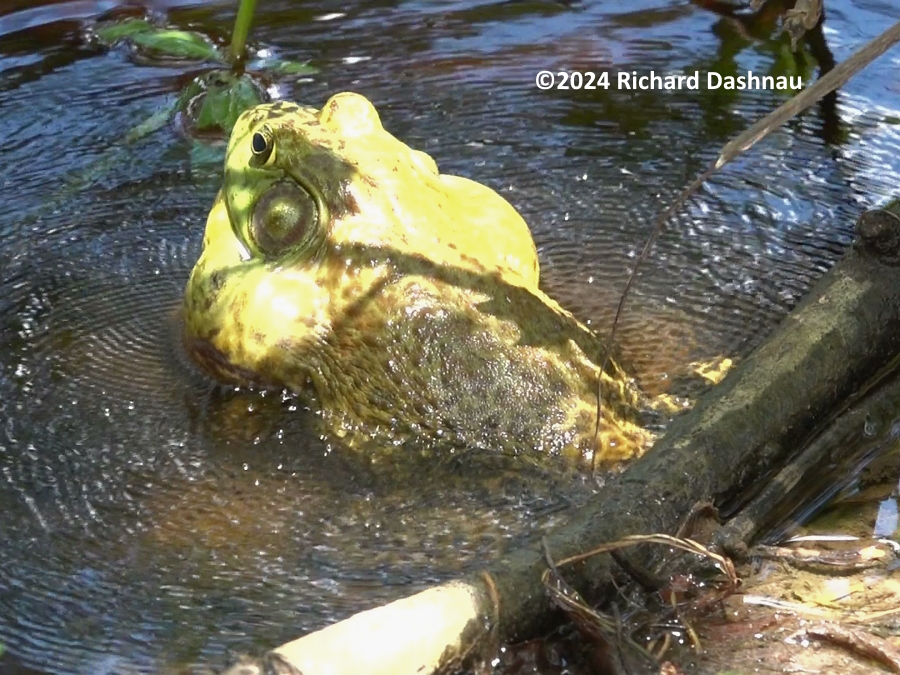
08/15/2021- I was near the Observation Tower at 40Acre lake,
when a visitor said she'd seen a snake go after a frog. The frog got away,
and I was able to get a quick look at the snake through my binoculars. It
was a Broadbanded Watersnake (Nerodia fasciata). It moved away before
I could point a camera at it. Then I noticed a group of small frogs
about 15 yards away, on the surface of the lake. As can be seen in the
photos
of the alligator nests and the frogs, the lake on this side was covered
with a mixture of plant matter. The small frogs were resting on that.

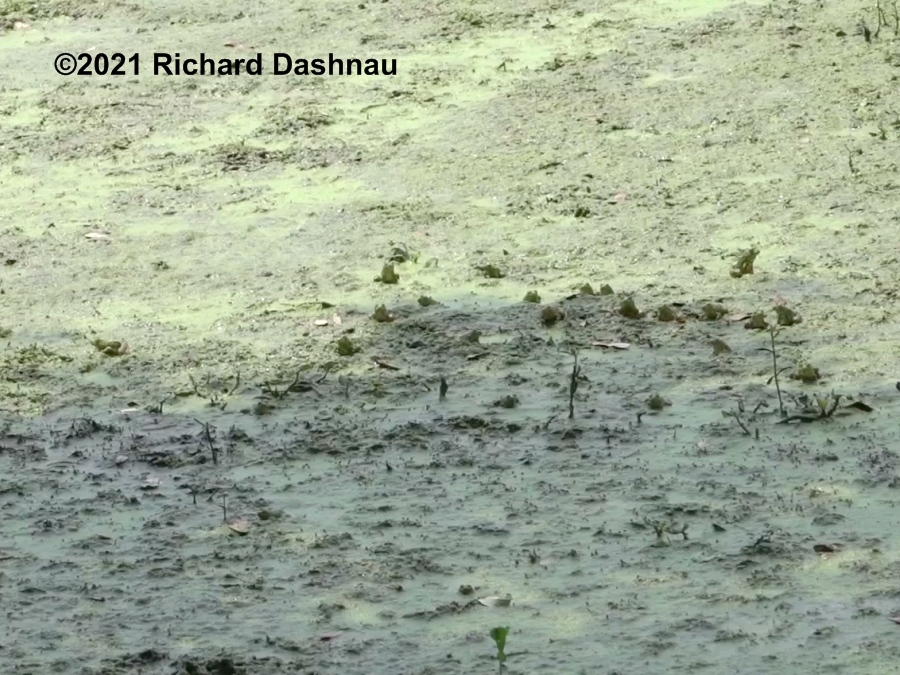
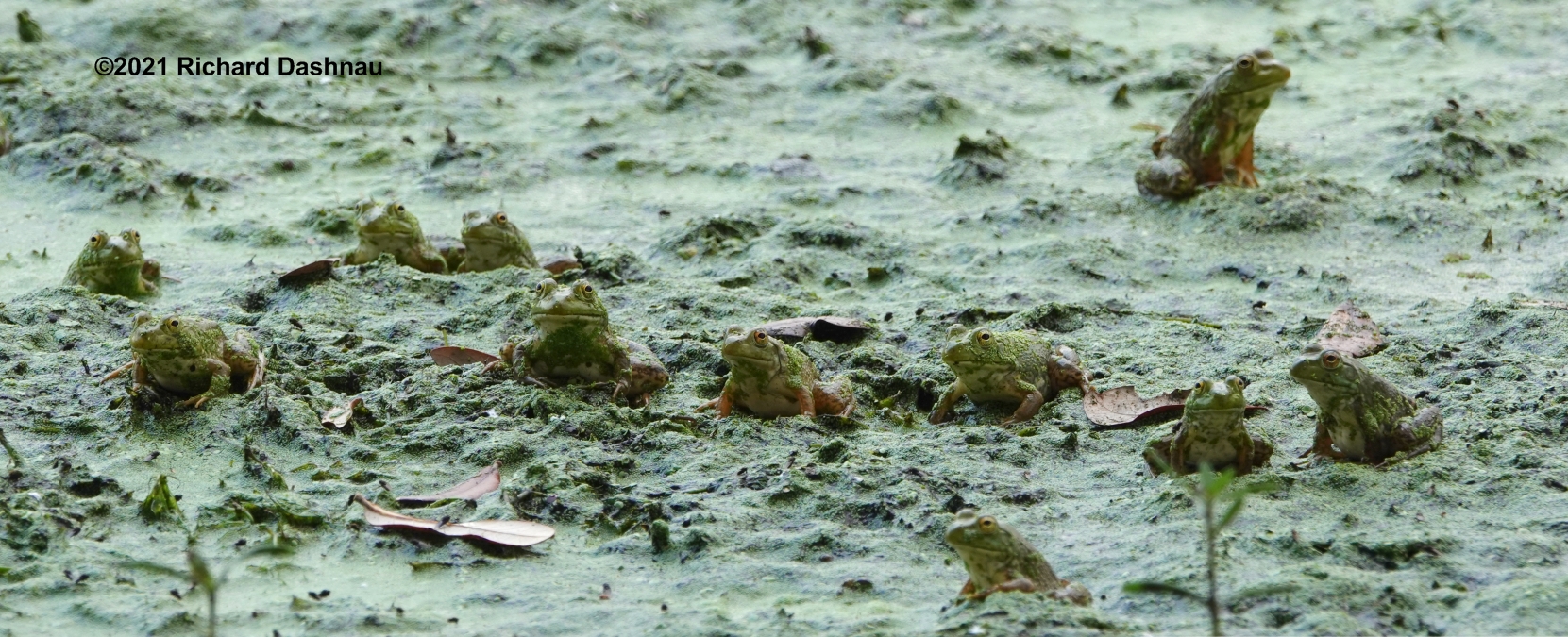
Frogs are out there!
Zooming in to see the
frogs.
There are the frogs!
When I looked closer, I could see part of the reason the frogs were
gathered there. There were lots of flies there--buzzing around the frogs
and landing near them. I didn't see any flies get eaten; but the little
frogs looked like they'd eaten a lot already. I've tried to identify the
frogs.
Both American Bullfrogs (Lithobates catasbaeiana) and Bronze Frogs
(Lithobates clamitans) live in the park. Although I've heard the calls of
both frogs-
bull-fiddle "rum-ur-rum"sound for Bullfrogs; single-plucked banjo notes
for Bronze Frogs-I can't recall ever seeing any adult Bronze frogs, but
I've seen
many Bullfrogs. Bullfrogs have a "ridge"or "fold" that curls behind
their eyes and down around the ear. Bronze frogs have a "ridge" or "fold"
that runs
at the edge of their back, from head towards hindquarters. I think I can
see the ear ridge on a few of these frogs (not easy to do, since they all
seem to
be facing me), so at least a few of them are probably Bullfrogs. I also
shot a
bit of video so we can all share some time with this group.

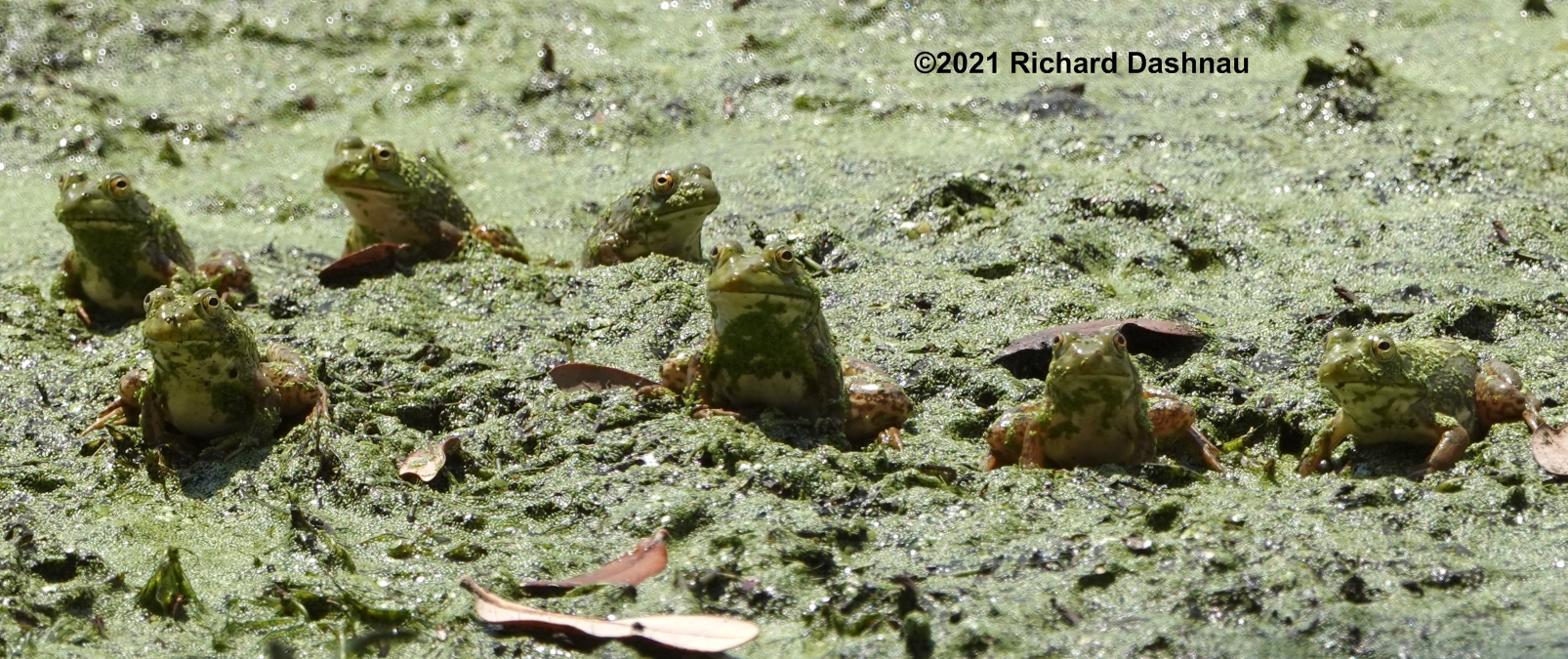
Wide shot of the group.
Cropped view of that shot.
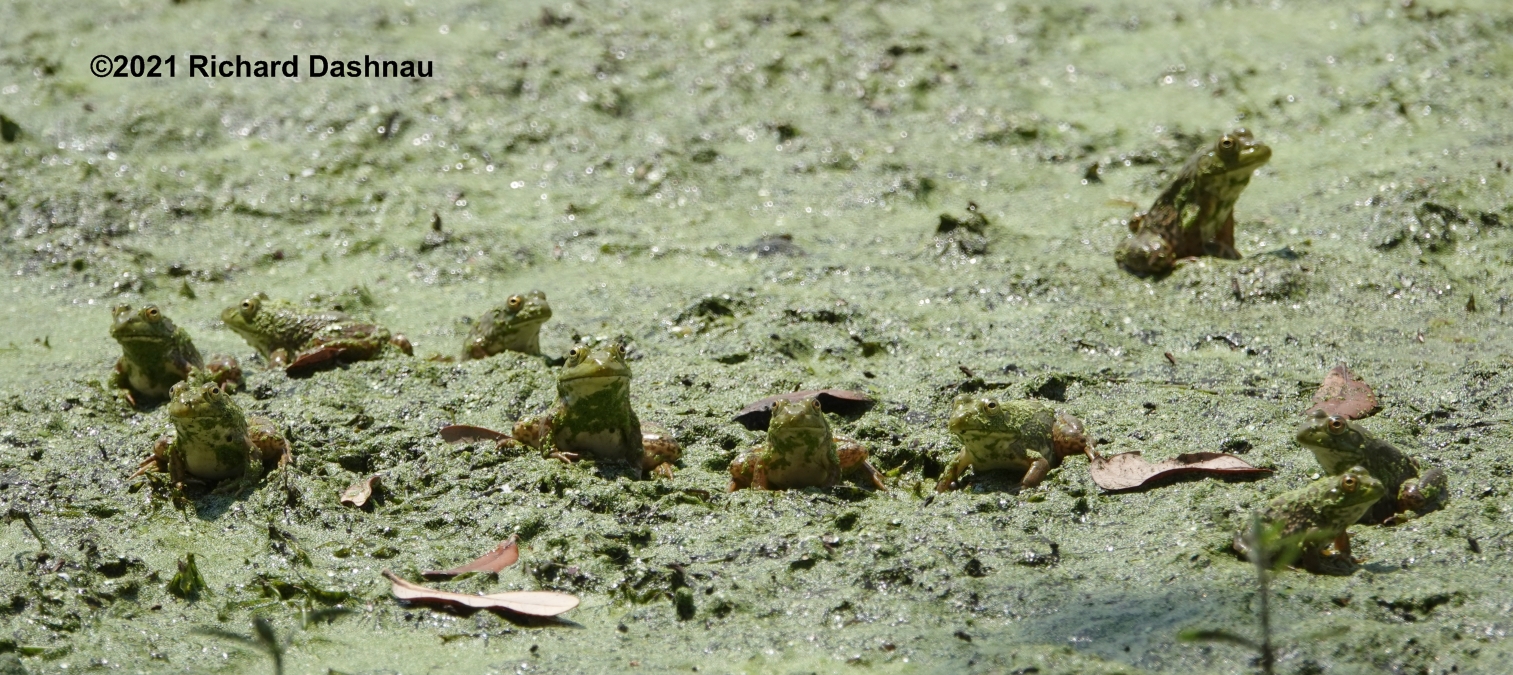
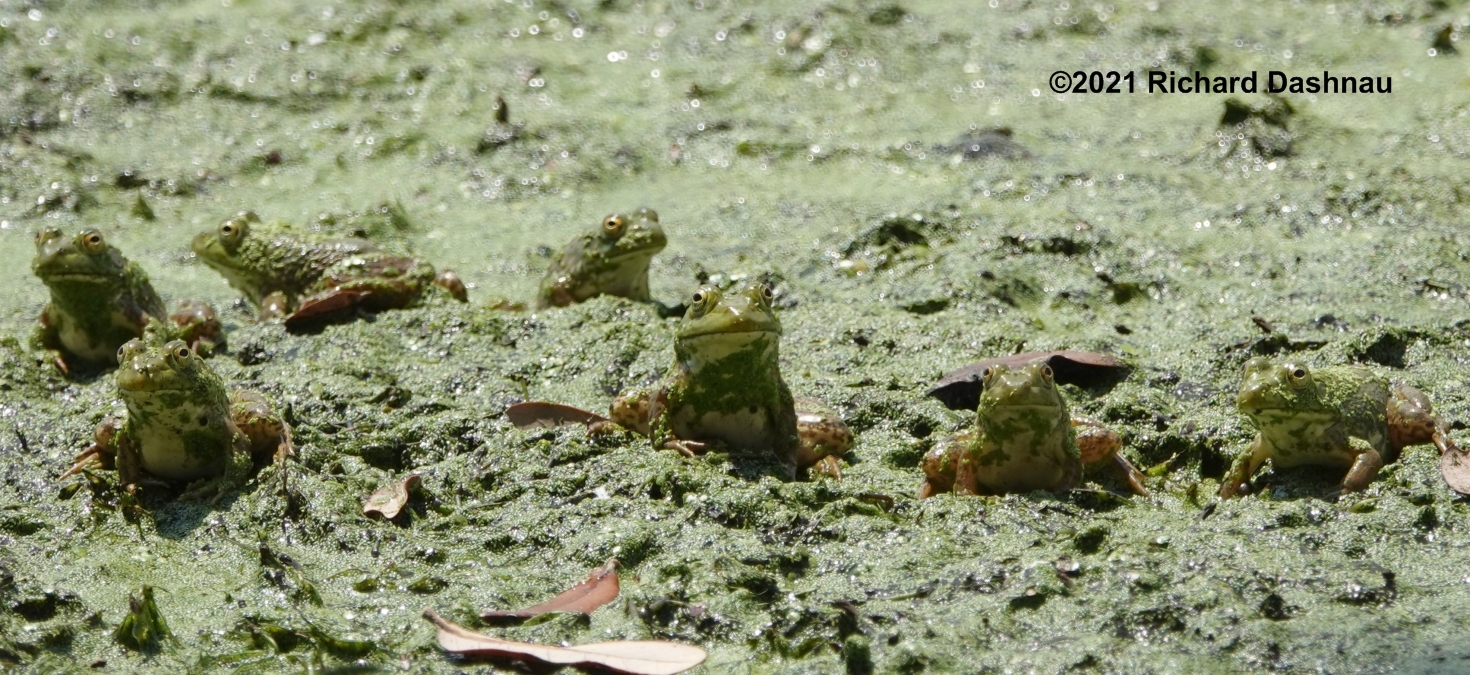
Wide shot of the group.
Cropped view of that shot.
02/20/2021
A
few days after the Big February Freeze of Texas, I was out
at Fiorenza Park North again. On the same morning, I looked near the
bridge and was very
surprised to see a Bullfrog (Lithobates cataesbiana) in the water.
Then, I noticed it wasn't just a single frog, but a stack of them!
And, they were alive! Now, this was
just a few days after our major freeze, and large amphibians
were the last thing I expected to see. In fact, I'd gone out that day
expecting to see dead armored catfish--and I didn't see any of those. I'd
seen an armored
catfish mass-death at that park in 2018. I have pictures on my page here.
Anyway, I was curious about this, and I could not find
anything online, or in my limited
library, that described why the frogs were doing what they were doing.
I was also curious about how the water temperature might have been a
factor in their behavior
and in the lack of dead fish. I found temperature data for that week at
three different websites, and I graphed them. This is air
temperature, of course, so I
am not sure how quickly these temperatures would change that of the water.
The graph is the first image below. I suspect one of the lines of
data ended near 18F when it lost
power (like a lot of the area did). The images below show the frogs.
I noted that they were against the concrete, and in the direct sunlight. I
assumed that they were
trying to absorb heat. The "stack" was interesting. The extremely
dark color of their skin seemed wrong. It could be temporary adaptation
for the cold (for better absorption
of infrared). I couldn't find information about it.
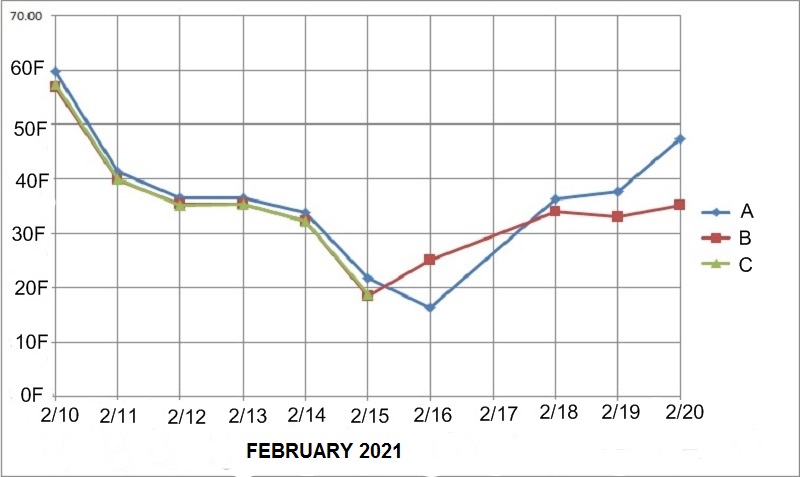
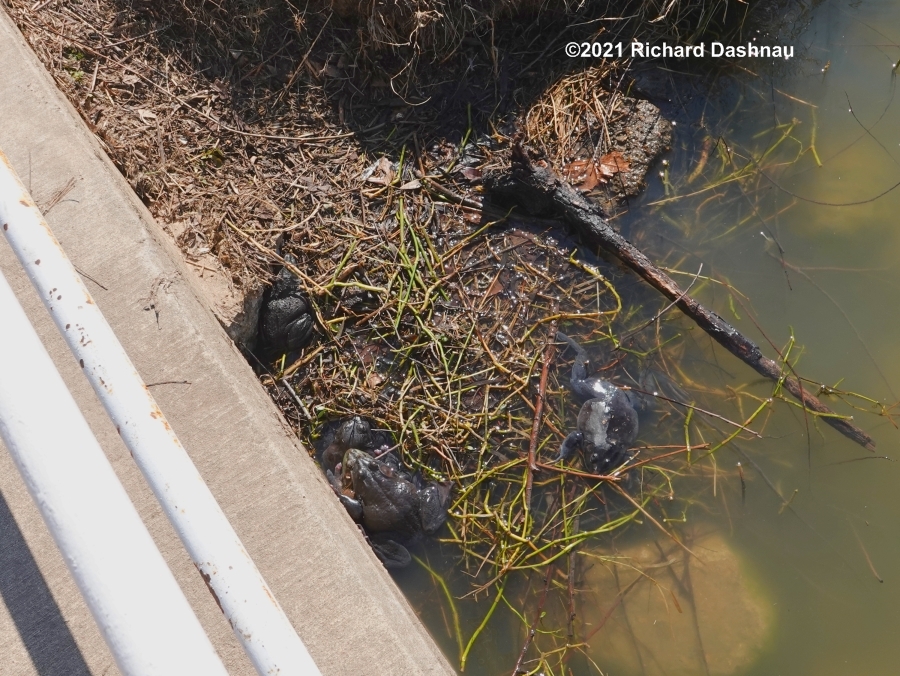
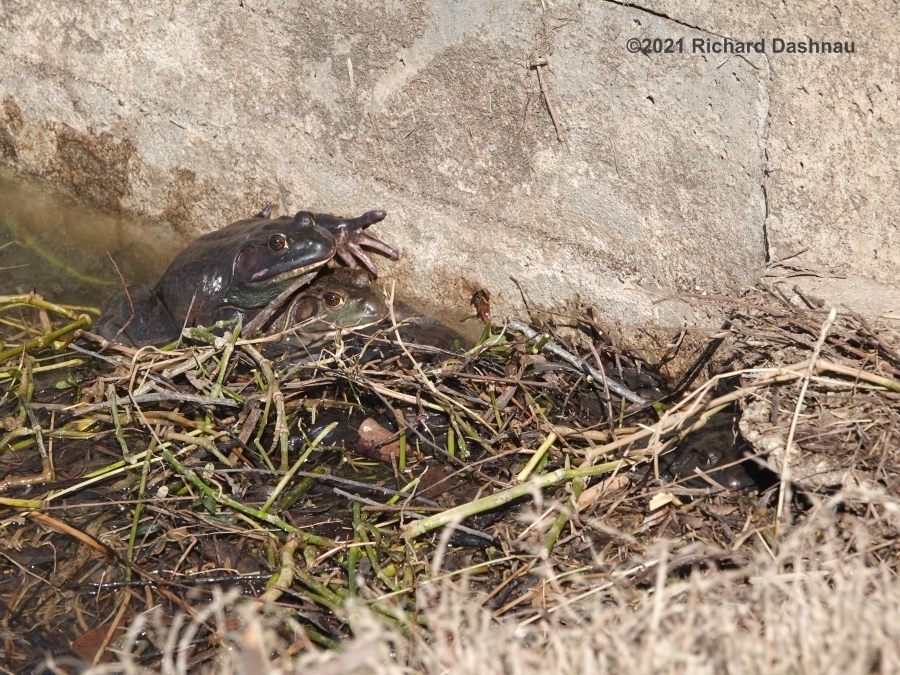
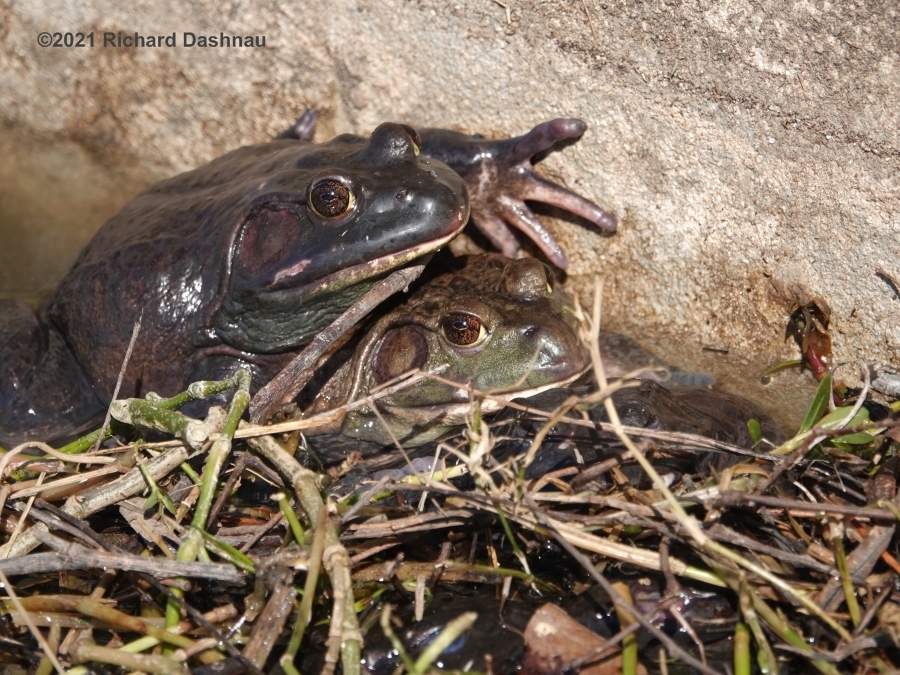
Temperature data for the week before.
There were 5 or 6 frogs down
there.
There's at least one in the grass alone in front of
the stack.
From what I can see in the pictures, the "stacked" frogs are males (the
ear is larger than the eye). The one that was floating alone in the water
seemed to be dead. I did not
bother any of the frogs, or get too close...so I did not check. I
was reluctant to bother the frogs because I figured that the frogs had
just survived the same freezing
event that we all had. Bullfrogs live in the Northeast U.S., so the
species can survive what I call "true winter" (it's cold enough for long
enough to freeze the qround to some depth,
and to form thick ice over bodies of water). But here, such
conditions are rare, so I assumed that the frogs were doing their best to
recover from a rare disaster. This meant that they were in the
spot and position they needed to be for the best thermal yield. I was
concerned that anything that moved them would add more physical stress.
So, I left them alone. I was concerned
that some other person might bother or take them (since I had found
them)--but I had to leave the frogs in place.
I went back on 2/23/2021! The frogs were not where I'd seen them 3
days before, of course. But after a short while, I found them
again. This time, they were hiding under better
cover, in the shade of some trees. I was happy to see they were
still alive. So, I took a few more pictures (the last 3 below)
before leaving them alone before someone
else saw me watching the frogs.
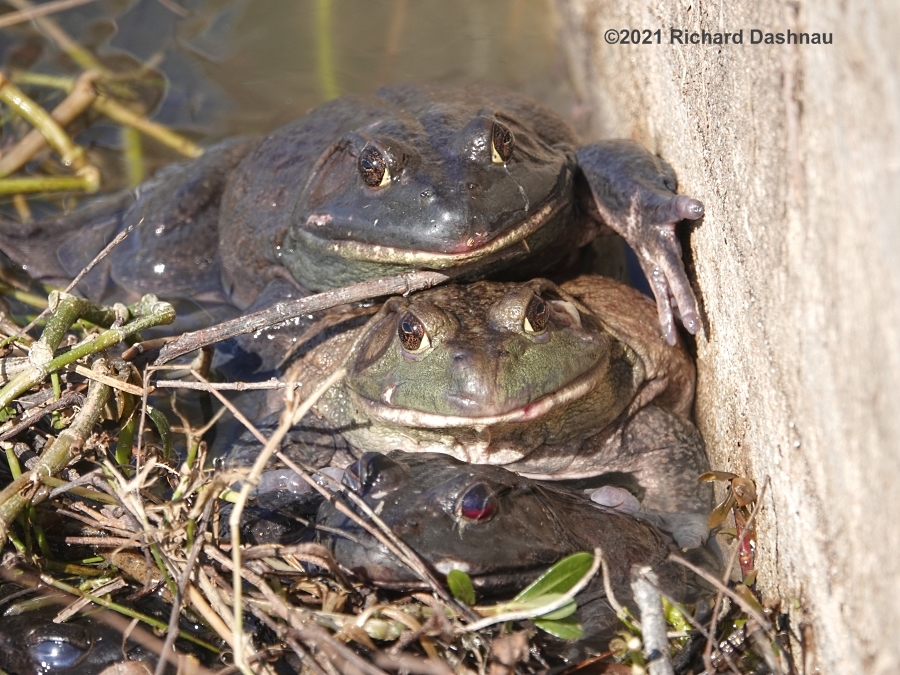
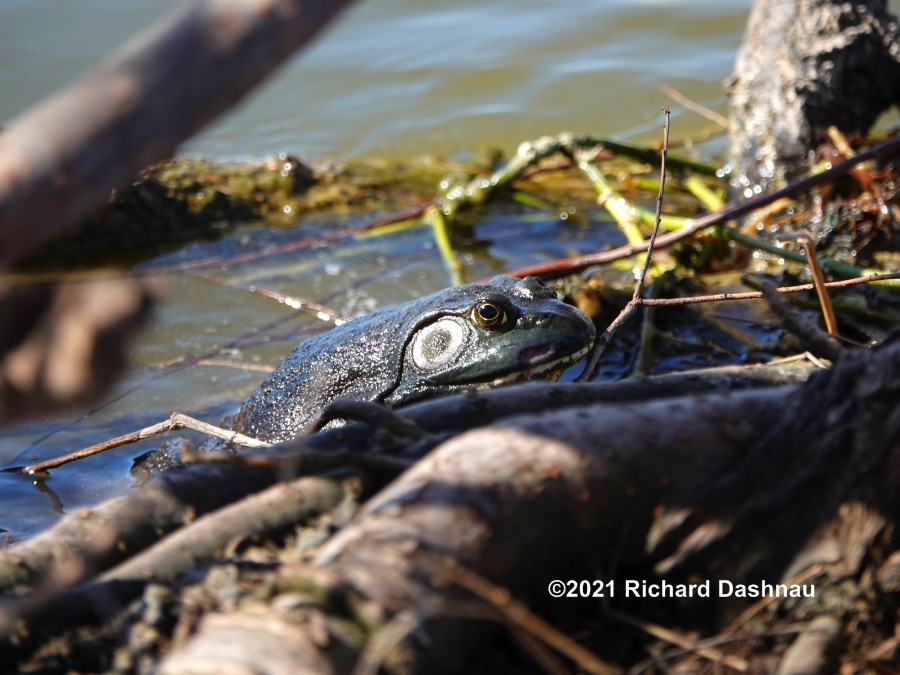
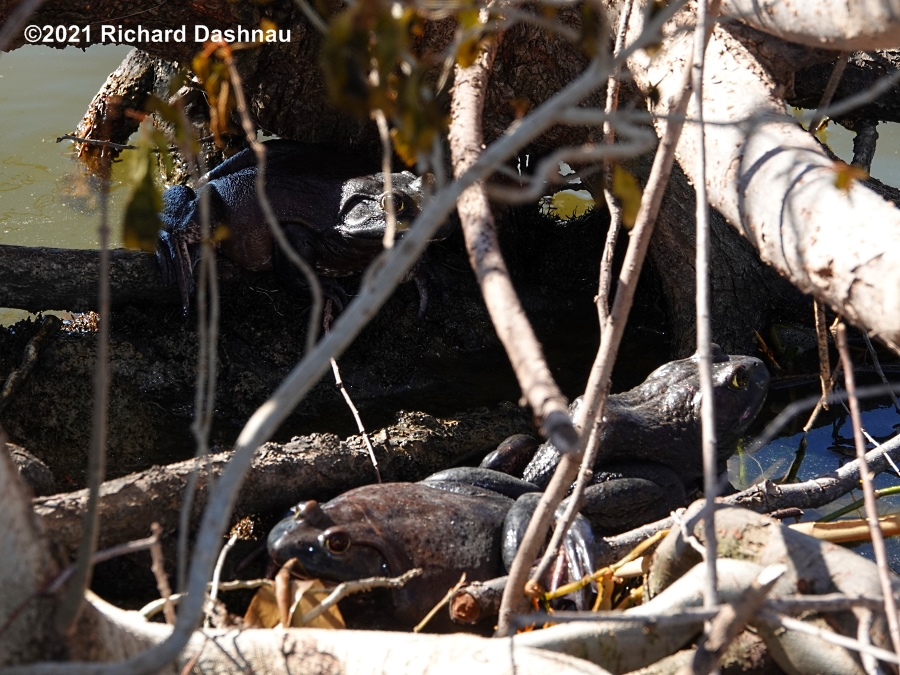
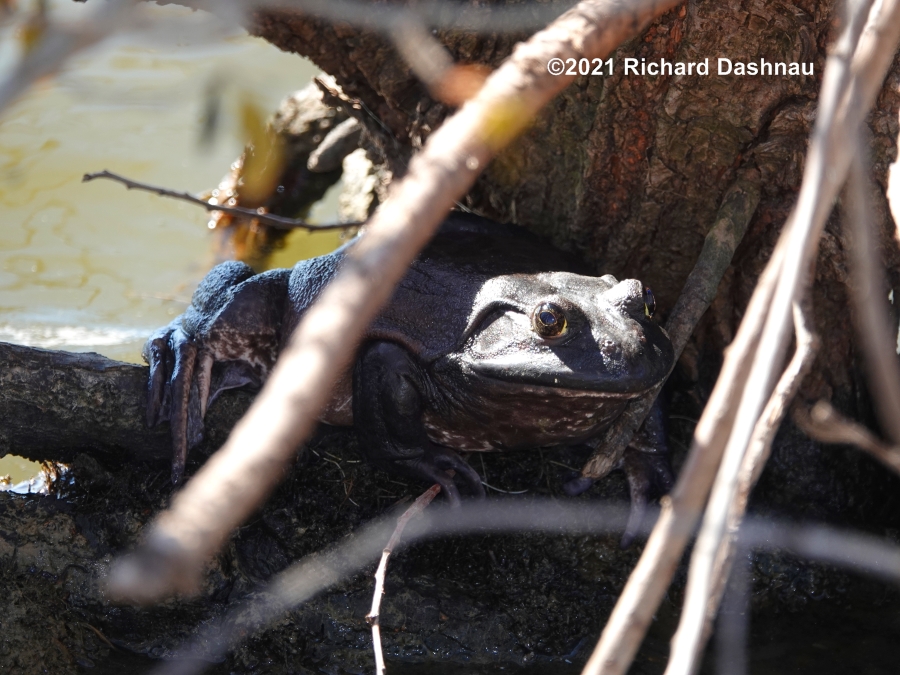
3 in the stack, one to the left.
One under a
tree a few days later.
Looks like 3 more under the tree.
The lighting was tricky, but here's one.
05/07/2017 Bullfrog calling...revisited
Last year, I discovered that male bullfrogs' ears are
twice as large as the females' not to hear better than the females.
Instead, the large ear helps increase the power
of the bullfrog's call. That is, the large ears don't help them hear
better....the large ears help them sound better! Since then, I've
been trying to get better video of male bullfrogs calling. I have finally
captured
some video at 480 frames per second (FPS). The video clearly shows
the movement of the ear membranes.
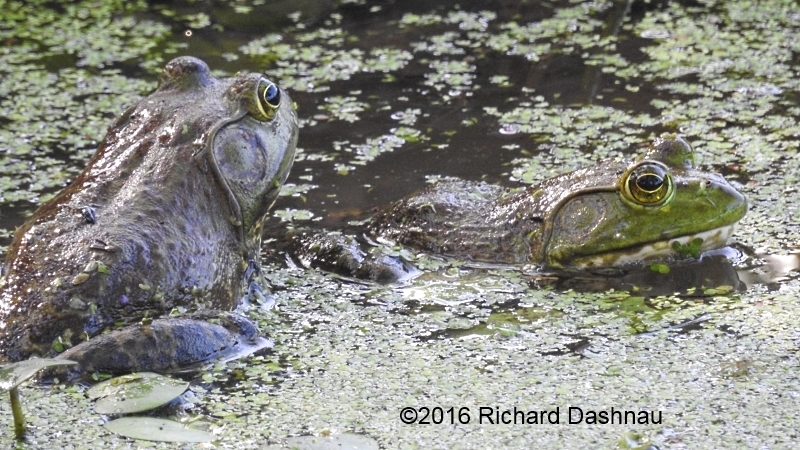
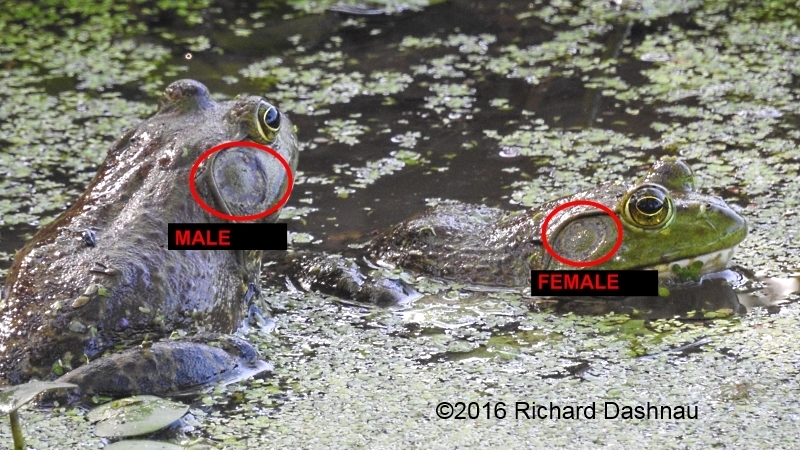
The two images below are frame grabs from one of the video clips. The
images show one ear membrane distended, and then collapsed. The video is
at this
link (mp4).
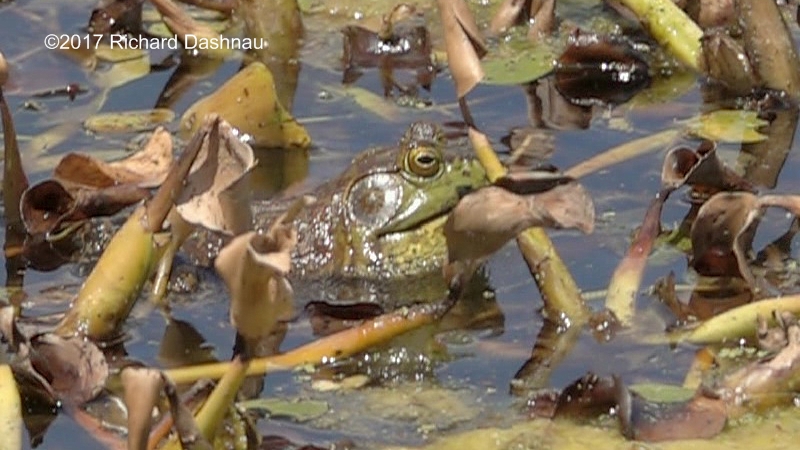
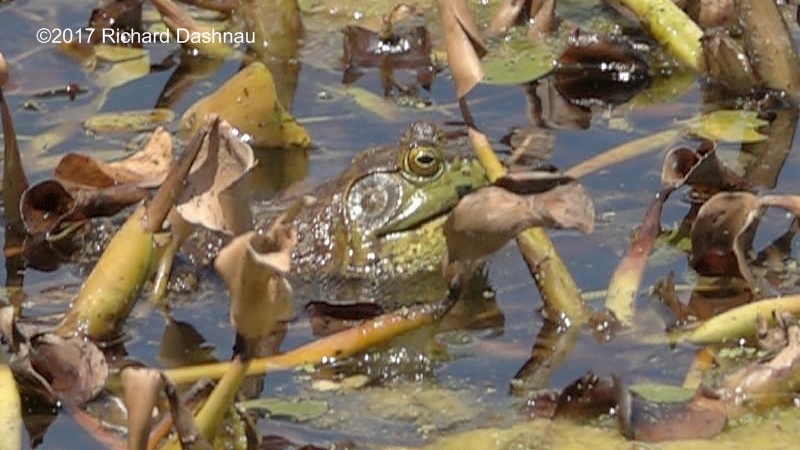
4/10/2016 Bullfrogs have been calling in
the park. I'm a little ashamed to say that up until now, I'd never
considered taking a close look at what they are actually doing. Bullfrogs
are usually a bit
shy, and tend to call from cover--or, they'll stop calling and jump away
before they can be seen. For the last few weeks the Bullfrogs have been
calling along the Spillway Trail, and have been
easy to see in the corner of Pilant Lake near the Elm Lake water station.
With all that "talking" going on, I was able to get a very good short
video clip of a bullfrog calling, along with that odd
"poot" sound that they sometimes make. I wondered about that sound, and
scanned the Internet for some hint about how or why it happens. I
discovered some interesting things about
bullfrogs and their calls. Bullfrogs actually make a number of
different sounds. Males usually do the calling, though females may
vocalize occasionally. The most common is called an
"advertisement call". That's the loud "Ruh AMH", or "Jug o RUM"
call. The less-impressive "poot" noise is an "encounter call", or
"territorial sound", and is made to warn off or challenge other
male frogs that have wandered into a frog's territory. One study
shows that male frogs respond more often to frogs calling from further
away than to those closest--possibly since they already
know where the nearest males already are, and therefore their territories.
Also,in a particular area, different frogs will start the chorus on
different days. They sort of..."take turns". And, since
calling is an "advertisement", it draws attention to the caller--and this
includes territorial aggression by other frogs. Some male frogs avoid this
aggression by a behavior called "satelliting".
The "satellite" frogs remain quiet during the advertisement chorus,
although they know where the calling males are. When a female is drawn to
one of the advertisers, the "satellite" frog
intercepts and mounts it before it can get to the calling male. Pretty
sneaky, eh? The study is referred to on this page. But wait...things get a bit stranger.
The ears on male Bullfrog ears are about twice as big as the ears on
female Bullfrogs. A Bullfrog's ear can be identified by the big circles
just behind the eyes. Those circles are actually
membranes (tympanic membranes) which work like our eardrums. Vibrations
through the air (sound) cause the membranes to vibrate, and that vibration
is transmitted internally by mechanical
linkages to the organs that change it to nervous impulses. Previously, I'd
read somewhere that the males' ears were bigger to give them better
hearing during mating communication. But
apparently that's not the case. In this study: ("Function of the
sexually dimorphic ear of the American bullfrog, Rana catesbeiana:brief
review and new insight" (2009), by Y. L. Werner, J. Pylka, H.
Schneider, M. Seifan, W. Walkowiak and U. Werner-Reiss; I found it at this
link) they find that although the male membrane is larger,
there are some aspects of the anatomy of the male ears
that offsets the larger membrane size. For example there is a
cartilaginous pad in the middle of the ear where the sensor bone structure
rests on the membrane (it's the dark center of the ear
membrane). On male frogs, this pad is thicker--which offsets any
advantage from the larger membrane surface. After experimentation, the
function of the male and female bullfrog ears was found to
be not very different at all. So if the larger male bullfrog ear doesn't
make it hear better than the female; WHY would it be that way? How could
it benefit the male bullfrogs?
This paper may have an answer: ("Tympanic sound radiation in the
bullfrog Rana catesbeiana"(1997), by A. P. Purgue.) The
abstract is here. The
experiments and results seem to show that as the
frog calls, the ear membrane vibrates and helps add power to the call. The
larger ear helps the call by adding about 20 dB (decibels) at the
"dominant frequency" of the call (about 250 Hz range)
and adding about 60 dB at the high-frequency part of the call (about 1000
Hz). The bullfrogs may be "calling" with their EARS! After I'd
learned this, I intended to shoot more video of bullfrogs
calling (my camera has the reach) to see if I can catch this vibration-but
the park is currently flooded. However, when I examined my video
mp4, which I shot on 4/10/16, I found
that it's possible to see the vibration. The video
clip mp4 is short, and I've cropped and slowed down the area of
the eardrum to show it better. It looks like it's moving! That
is amazing.
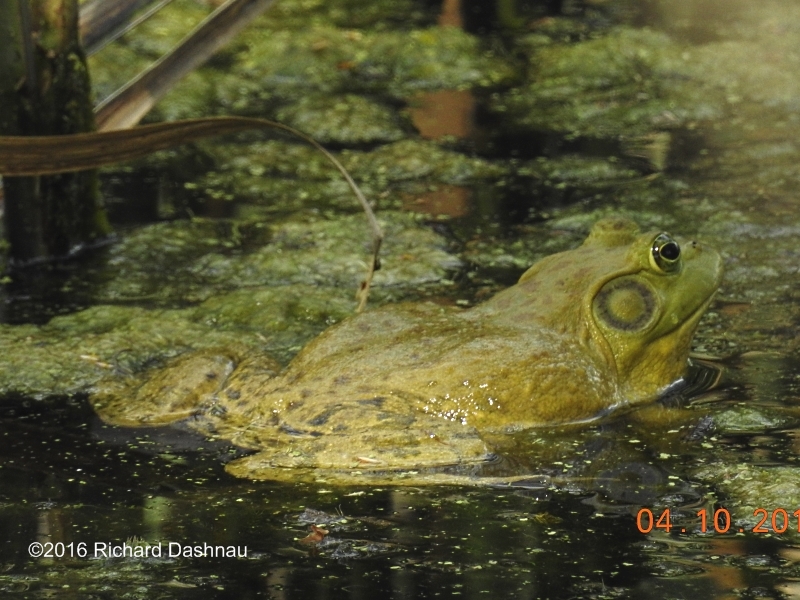
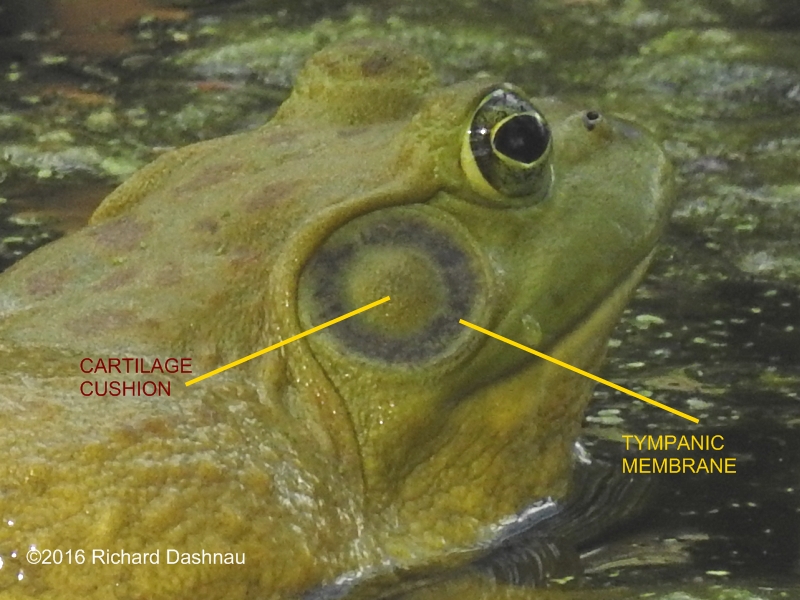
August 09, 2015
Bullfrogs are active around the park, although they were not calling
this morning as they have been over the last few weekends. While I was
walking West on the Spillway trail
(on my way back to the Nature Center to work a shift) I noticed one
Bullfrog seemed to be watching something. It's hard to explain why this
frog caught my attention, but I knew that something
was up. This could be partly due to my experiences with the Bullfrog I'd
kept as a pet for quite a while long ago. I used to watch it hunt in its
terrarium home. Anyway, I had just enough time to
start filming him with high-speed video. I didn't want to move closer
and possibly scare him, so I stayed back where I was. The sequence
of pictures below are frames from the video clip.
The video clip (filmed at 210 FPS) is here (wmv). I shot the RICKUBISCAM closeup as
a photo with a different camera. The gender of a Bullfrog can be
determined by looking at its ear
membrane (the circle just behind the eye). If it is smaller-or about
the size of the eye, then the frog is female. If the ear is larger than
the eye (usually much larger--as in the picture), then the
frog is a male--at least for Bullfrogs. Bullfrogs will eat anything
they can catch and cram down their throat. This can be worms, insects,
crawfish, even smaller frogs. In this case, the prey
seemed to be a fuzzy, white caterpillar. I'd thought I might be able to
identify it later, but there are MANY "fuzzy white caterpillars". I
was happy to be able to catch this frog's leap and slow it down.
IMAGE SEQUENCE OF THE FROG'S LEAP:
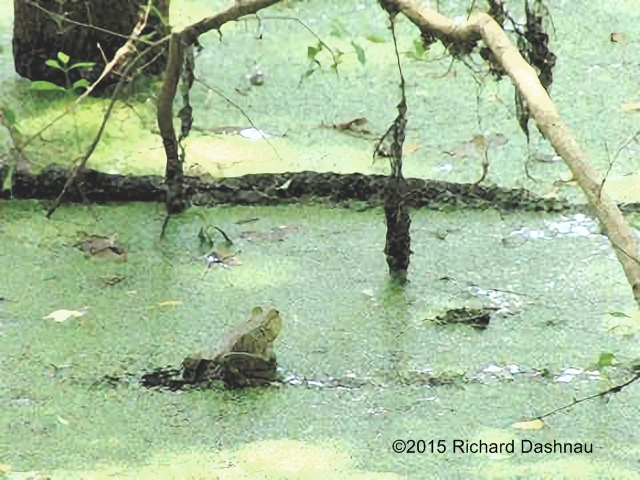 --
--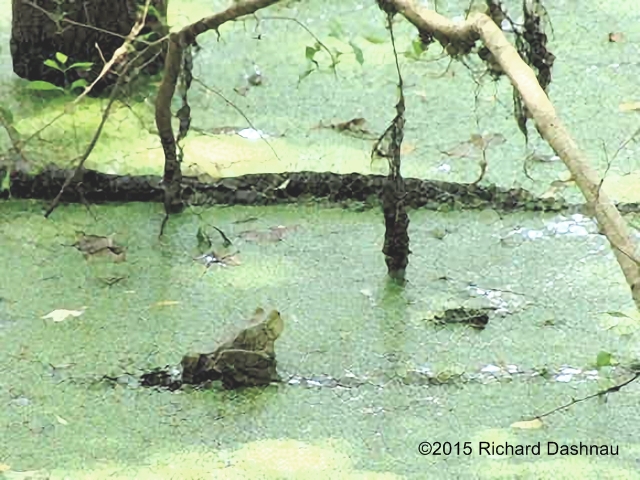 -
-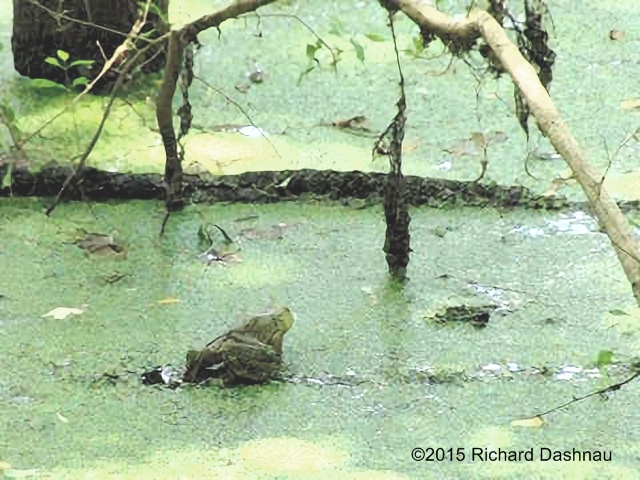 --
--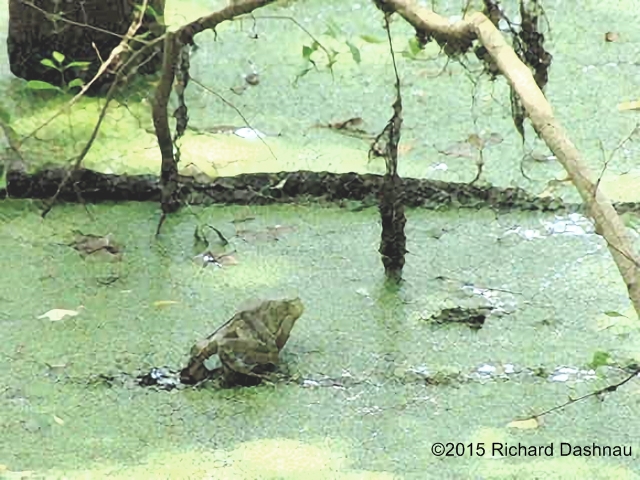
It's not usually obvious, but frogs can turn their heads. This
head-turning is what caught my attention. As the frog focused on its prey,
it turned its body ("aimed" its body) by
shifting position of its rear legs. With the prey properly in its sights,
the frog "fired" by jumping.
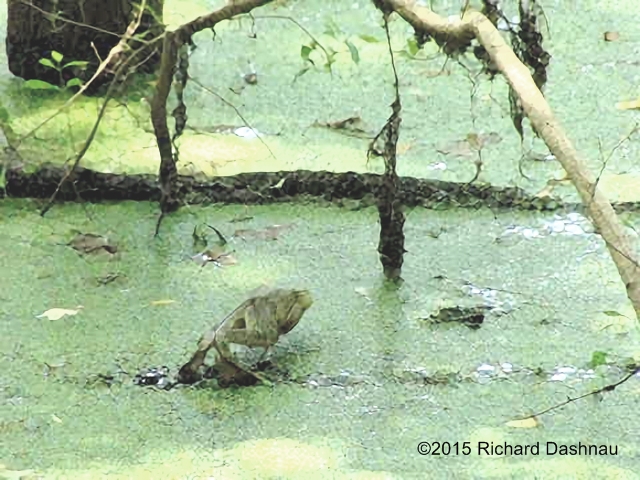 --
--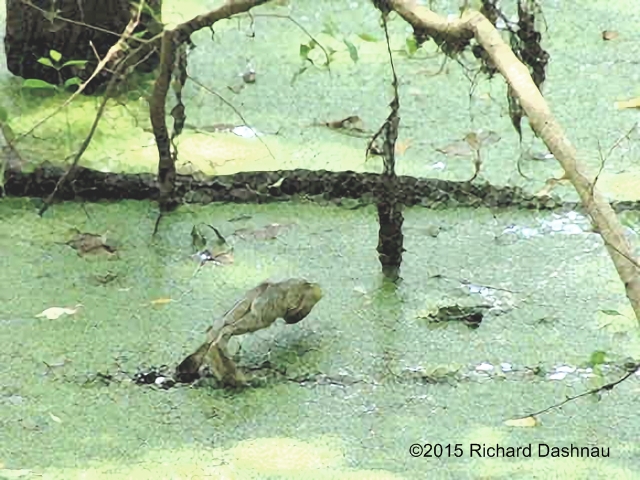 -
-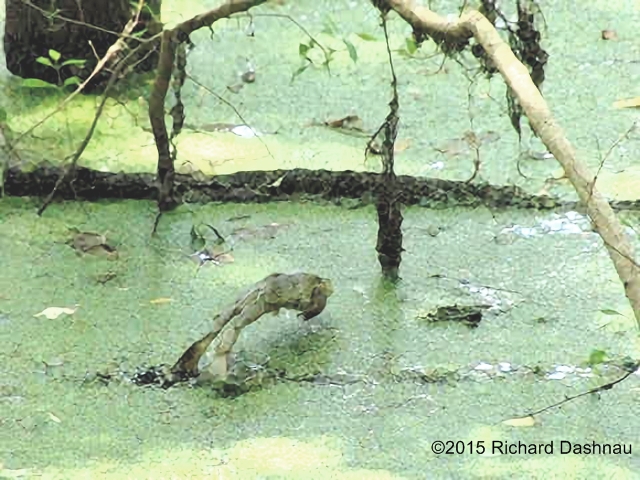 --
--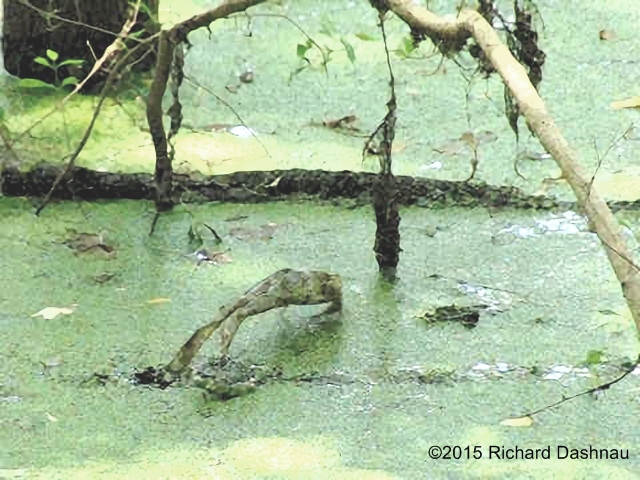
Now an amphibian missile, the frog flew towards its target. Note the front
legs tucked in close to the body. Imagine having to eat by launching
yourself, FACE FIRST-at high speed-at
your food. Also consider that this food is alive, and would fight back if
it could.
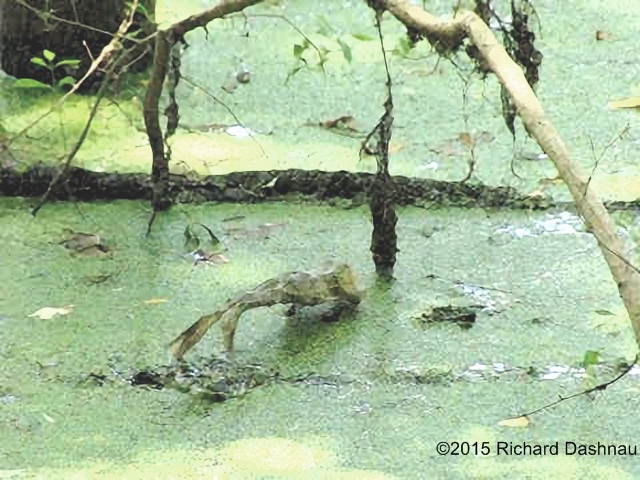 --
--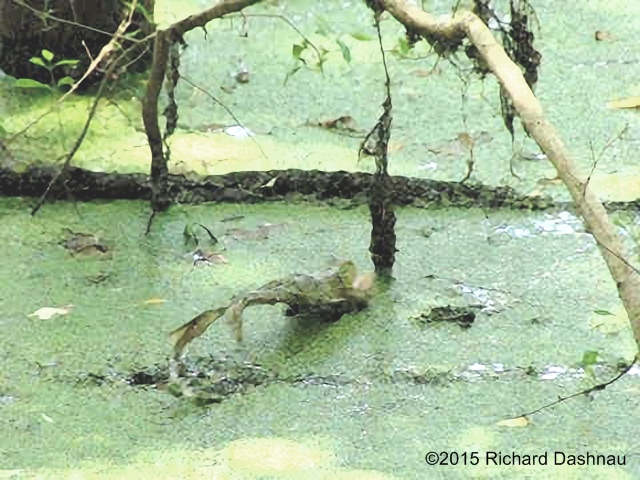 -
-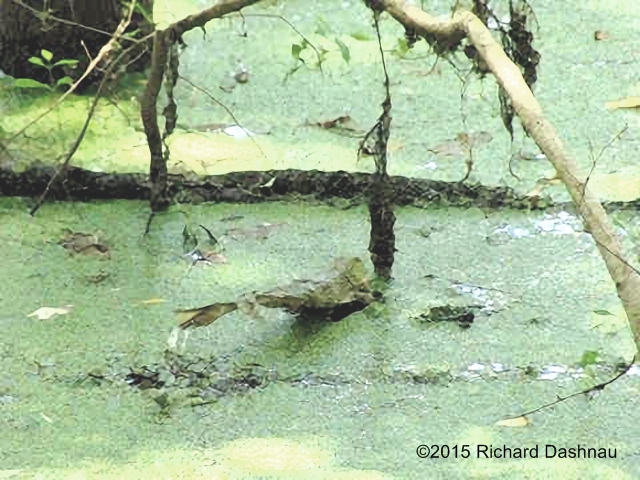 --
--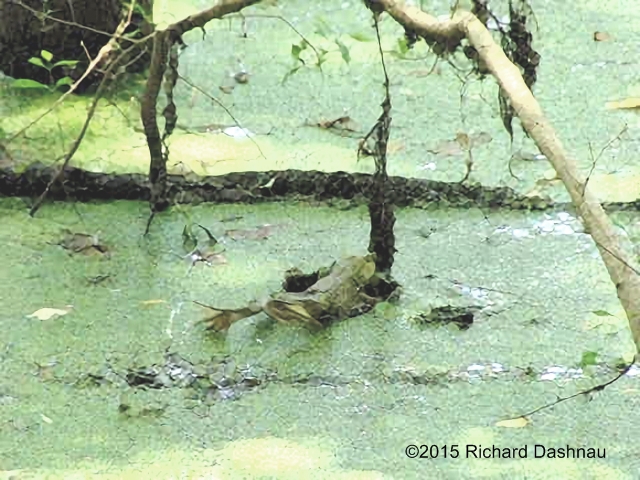
TONGUE GRAB!
Just before reaching its target, the frog launched its tongue. What
amazing timing this must take! The airborne frog, launched fast enough to
fly horizontally, launched its
tongue with enough time to pull it and prey back into its mouth before
hitting the water.
A Bullfrog's tongue is attached near the front of it's lower jaw (not near
the back, as ours is). Therefore the tongue (which is sticky) flips out,
snags prey, and flips it back
towards the frog's throat. In the second picture above (TONGUE
GRAB!), the tongue shows as the pinkish spot just in front of the frog.
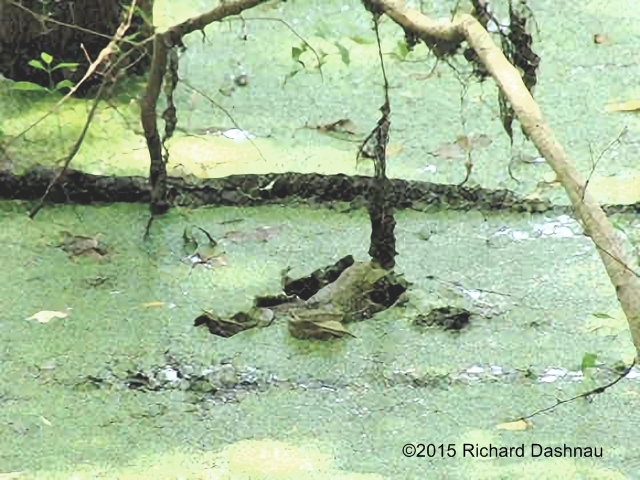 --
--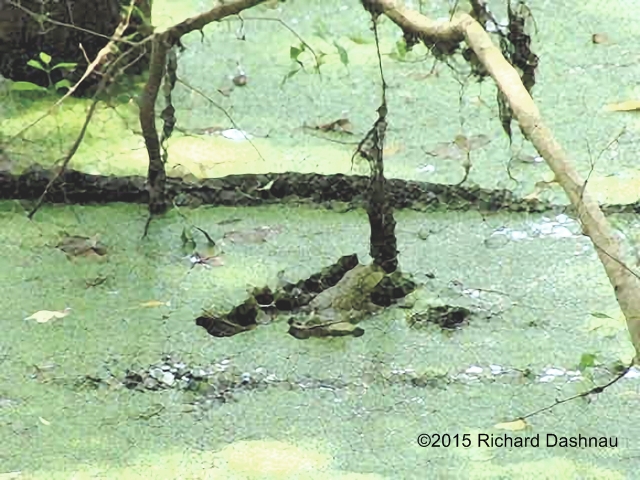 -
-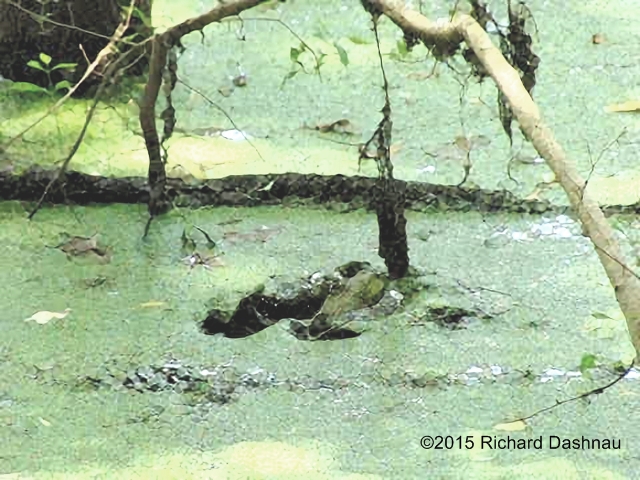 --
--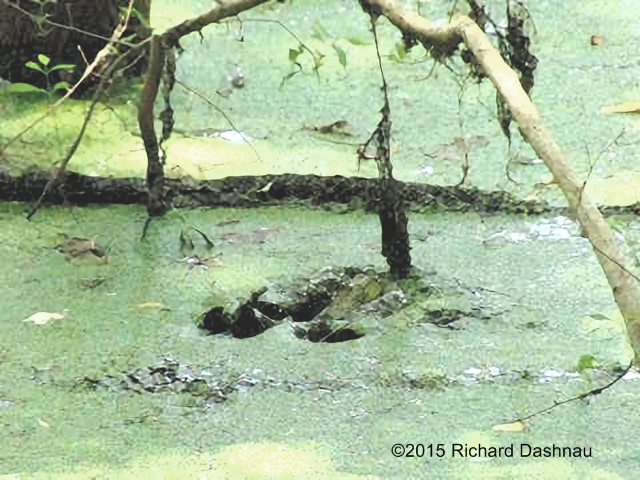
Then the belly-flop landing. With the prey having been caught,
stealth is no longer needed-although this kind of commotion can draw the
attention of competing male frogs or ...predators of
frogs. The front legs have extended, also, and are sometimes used to push
struggling prey into its mouth.
01/04/2009--Slow-Motion clip of a Bullfrog leaping out of frame
at BBSP. The video could have been better, but it still shows
some interesting things. The frog expelled a string of large
droplets near the top of its
leap. It seems to me that the droplets striking the water could be a
form of visual (and aural) distraction. Since the stream hits within
the flight path of the frog,
watching eyes would be drawn to
these splashes, while the camouflaged frog could be lost from view.
Click this link for the video.
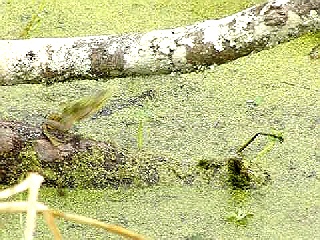
08/06/2006--Finally, there is one
more clip 4840 wmv . This is of a bullfrog calling, and the
little "poot!" noise that Bullfrogs make sometimes after a bout of
calling.
------------------------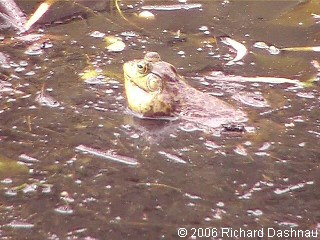 -
-
HI
DIDDLE DIDDLE AMPHIBIAN BULL FIDDLE
VIDEO
CLIP 4840 kb wmv
A large number of Bullfrogs can be heard in the clip. It is illegal to
catch or molest any animal (with the exception of fish) at BBSP. Frogs
cannot be legally caught IN ANY WAY at BBSP. Although
fishing is allowed, State fishing regulations must be followed.
Leave the animals you see at BBSP alone, so that other visitors may
enjoy seeing them (and also to avoid being ticketed and fined).
April 27, 2003 I have one more clip to answer a question that many
visitors have asked.They keep asking what this loud "jug-o-rum" sound
is. The culprit is the Bullfrog (rana catesbeiana).
I've finally been able to get one on video as it's calling(see WHERE'S THE
BEER?, below; or see the clip flv
video 308 kb ) . Listen to this, and compare to the various
alligator bellows on my pages.
------------------------------------ ----------------------
----------------------
--------------------------
-WHERE'S
THE
BEER?
Go back
to my home page, Welcome to
rickubis.com
Go back to
the RICKUBISCAM
page.
Go back to
the See the World
page.




























 --
-- -
- --
--
 --
-- -
- --
--
 --
-- -
- --
--
 --
-- -
- --
--

 -
- ----------------------
----------------------